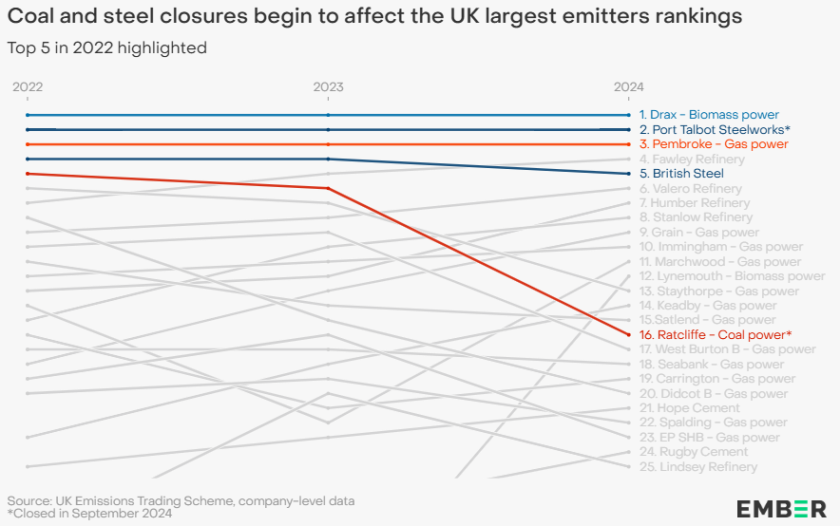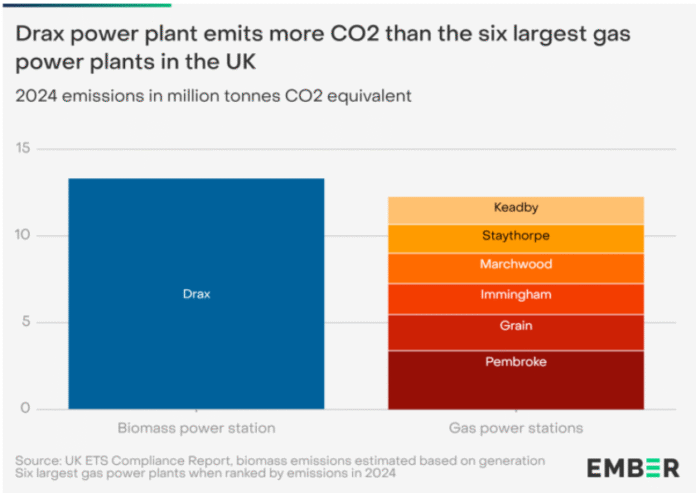Drax Power Station remains the UK’s largest single source of carbon emissions, emitting 13.3 million tonnes of CO₂ equivalent (CO₂e) in 2024 — a 16 percent year-on-year increase. This growth further widened the emissions gap between Drax and other major industrial and energy polluters, solidifying its position as the UK’s top emitter for the tenth consecutive year.
Drax alone emitted more carbon than the next four largest UK emitters combined and more than the six most polluting gas power plants combined, despite its continued classification as a renewable biomass facility, the Ember report indicated. This sharp rise in emissions comes as coal and steel closures shift the emissions landscape, with Port Talbot Steelworks and Pembroke gas power station ranking second and third, respectively.
Key Highlights:
Drax emissions (2024): 13.3 million tonnes CO₂e (+16 percent)
Top 50 emitters: Contribute 18 percent of UK’s national emissions
Top 3 emitters: Drax (1st), Port Talbot Steelworks (2nd), Pembroke gas plant (3rd)
Biomass vs. Gas: Drax emits more than six most polluting gas plants combined
Power sector: 16 of top 25 emitters are power stations, dominated by biomass and gas
Outlook: Drax expected to remain UK’s top emitter until at least 2030 despite subsidy reductions
The top 50 emitters in the UK collectively accounted for 18 percent of the country’s total greenhouse gas emissions, with power sector facilities dominating the rankings. Power plants made up 16 of the top 25 emitters, but biomass, not fossil fuels, now leads sectoral emissions. The closure of coal facilities — notably Ratcliffe-on-Soar and Port Talbot Steelworks in September 2024 — has reshaped the emissions profile, leaving biomass and gas power stations as the dominant contributors.

Despite its increasing carbon footprint, Drax received approximately £2 million per day in public subsidies in 2024, and is projected to remain the UK’s largest emitter through 2030, even after biomass subsidies are halved from 2027. The continued reliance on imported wood — 7.6 million tonnes burned last year, 99 percent imported — raises sustainability concerns, especially with reports of deforestation in supply regions.
Lynemouth biomass power station became the 12th largest emitter in the UK in 2024, releasing approximately 1.7 million tonnes of CO₂ equivalent. Its emissions rose due to increased generation supported by a public Contract for Difference (CfD) subsidy, despite previous declines during the energy crisis. This marked Lynemouth’s return to the top 25 emitters list for the first time since 2021. However, its generation remains about 25 percent below average, indicating potential for further emissions growth.
Meanwhile, gas power stations dominate the UK’s top emitters list, accounting for 13 of the top 25. While gas continues to support grid stability, cleaner alternatives like batteries and long-duration energy storage are seen as key to reducing emissions and import dependence in the future.
Frankie Mayo, lead author at Ember, is calling for a policy rethink, highlighting the urgent need to phase down biomass and decarbonize heavy industry. They stress that subsidizing high-carbon “renewables” like imported biomass undermines the UK’s net-zero goals, especially when these facilities surpass fossil fuel plants in emissions.
This analysis underscores a pivotal shift in the UK’s emissions landscape: while coal is phasing out, biomass is emerging as a new high-emissions challenge, calling into question the true carbon cost of “renewable” energy.
Baburajan Kizhakedath

